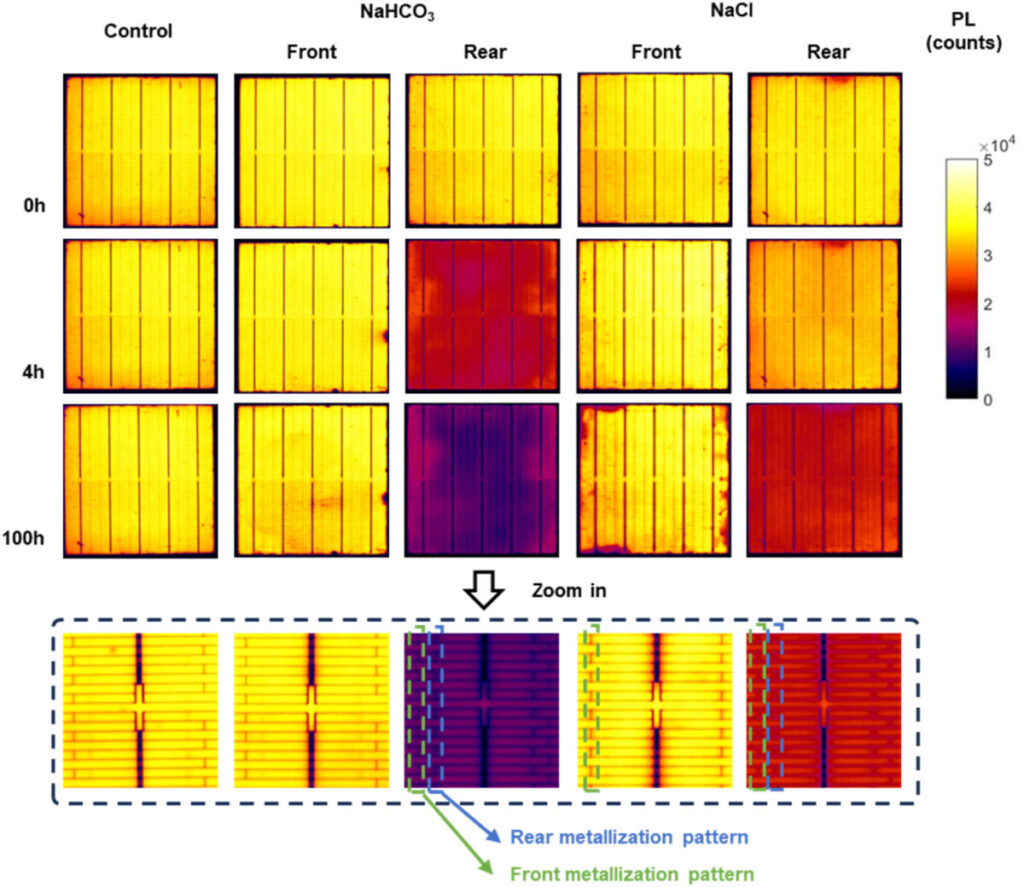Researchers from the University of New South Wales claim to have identified new TOPCon contact degradation mechanisms that are significantly affected by the combination of ions and aluminum-silver paste compositions. The primary degradation mechanism was a significant increase in series resistance.
Scientists from Australia’s University of New South Wales (UNSW) and Chinese-Canadian PV module manufacturer Canadian Solar have investigated the degradation of industrial TOPCon solar cells subjected to accelerated test conditions of 85 C and 85% relative humidity under the so-called moist heat test (DH85).
“Our findings highlight the vulnerability of TOPCon solar cells to contact corrosion, highlighting the electrochemical reactivity of metallization as a potential risk for the long-term operation of the module,” said the study’s lead author, Bram Hoex. pv magazine. “This study provides crucial insights into the cell degradation mechanisms of TOPCon, essential for optimizing the performance and improving the long-term reliability of these modules.”
Hoex explained that the study is complements and extends the research group’s previous work by using two types of sodium-containing salts, allowing the researchers to observe differences in the chemical reactions taking place. “This improved understanding of the underlying chemistry explaining the degradation is key to further improving the stability of TOPCon,” he added.
The group published an initial paper in late April identifying three new types of defects in TOPCon solar panels that were never detected in PERC panels. This work aimed to assess the impact of bills of material (BOM) on the reliability of both commercially available PERC and TOPCon solar cells.
“The results were quite surprising to us,” Hoex said pv magazine at the time. “We expected polyolefin elastomer (POE) to perform well overall, but we found that some POEs performed very poorly. This is likely due to the various additives used in the POE that react with the soldering flux and metallization, resulting in contact corrosion.”
In the new study, the scientists discovered significant differences between the sensitivity of the front and back of TOPCon solar cells when degradation was caused by two sodium-containing salts: sodium bicarbonate (NaHCO3) and sodium chloride (NaCl).
The academics conducted the tests using 158.75mm x 158.75mm G1 n-type TOPCon 5-rail solar cells. Their average energy conversion efficiency was 23.1%.
On the front, the devices were made with a boron diffusion emitter coated with aluminum oxide (Al2O3) and silicon nitride (SiNX), as well as a silicon oxynitride (SiOjNz) stack that provides surface passivation and acts as an anti-reflective coating (ARC). At the back, the cells had a TOPCon architecture based on a tunneling silicon oxide (SiO2) layer combined with a phosphorus-doped poly-Si layer, as well as a SiNX low ARC.
“The front metallization consisted of a combination of silver (Ag) and aluminum (Al, 3-5 at.%) as conductive material, while the rear metal contact consists solely of Ag for conduction,” the researchers explained .
Image: UNSW, Solar Energy Materials and Solar Cells, Common License CC BY 4.0
The DH85 assay was performed using scanning electron microscopy (SEM) images on five cell samples: reference cells treated with deionized water (DIW) alone; cells exposed to NaHCO3 at the front; NaHCO3 at the rear; cells exposed to NaCl at the leading edge; and cells exposed to NaCl at the rear.
As for the first group, the scientists found that exposing TOPCon cells to high humidity at elevated temperatures for long periods of time did not inherently lead to degradation. However, for the other groups the decline in efficiency was significant.
“Our accelerated test with NaCl causes an extreme degradation in energy conversion efficiency, resulting in a relative reduction of 92%, while NaHCO3 results in a relative efficiency reduction of 5%,” Hoex said. “The main degradation mechanism is a significant increase in series resistance (Rs), probably due to electrochemical reactions in the silver-aluminum (Ag/Al) paste.”
“When applied to the back of the TOPCon solar cell, NaHCO3 increases recombination and deteriorates contacts, leading to a 16% reduction in efficiency after just 100 hours of DH85 testing,” Hoex added. “NaCl, on the other hand, mainly increases recombination and does not appear to affect contact, causing a 4% loss of efficiency. Further research reveals degradation mechanisms in backside metal contacts, particularly oxidation at the Ag-Si interface.”
The scientists emphasized that Ag/Al pastes are exposed to long-term stability risks when exposed to contaminants at the ion level and that other combinations at the ion level should be explored.
“In summary, this study reveals that the degradation mechanisms of TOPCon contacts are significantly influenced by the combination of ions and paste compositions,” the researchers said. “It provides crucial insights into the degradation patterns and underlying factors affecting the metal contacts of TOPCon solar cells, potentially helping to evaluate panel-level reliability.”
Their findings are available in the article “Revealing the cause of metal contact defects in TOPCon solar cells through accelerated moisture-heat testing”, published in Solar energy materials and solar cells. The research team also included academics from Nantong University and Shanghai Jiao Tong University in China.
In another study published in early April, the same research team collaborated with scientists from Chinese panel manufacturer Jolywood to design a laser-assisted baking process in the production of TOPCon solar cells that can reportedly increase contact quality and corrosion resistance while reducing production costs decrease.
The new technique, called Jolywood Special Injected Metallization (JSIM), consists of a laser-assisted baking process that uses a custom-made silver paste (Ag) to form the front contact on TOPCon solar cells. It is a low temperature baking technique intended to facilitate the penetration of the paste through the anti-reflective coating on the front of the cell.
“JSIM technology is already being produced in large quantities by Jolywood and other companies are also developing and implementing their own versions of laser-assisted shooting,” said the study’s lead author, Bram Hoex. pv magazine at the time. “Jolywood was one of the first manufacturers to adopt TOPCon technology for high-volume production.”
This content is copyrighted and may not be reused. If you would like to collaborate with us and reuse some of our content, please contact: editors@pv-magazine.com.
Popular content


